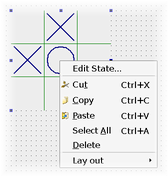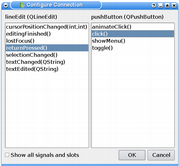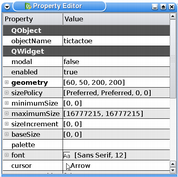Creating Custom Widget Extensions
Once you have a custom widget plugin for Qt Widgets Designer, you can provide it with the expected behavior and functionality within Qt Widgets Designer's workspace, using custom widget extensions.
Extension Types
There are several available types of extensions in Qt Widgets Designer. You can use all of these extensions in the same pattern, only replacing the respective extension base class.
QDesignerContainerExtension is necessary when implementing a custom multi-page container.
 | QDesignerTaskMenuExtension QDesignerTaskMenuExtension is useful for custom widgets. It provides an extension that allows you to add custom menu entries to Qt Widgets Designer's task menu. The Task Menu Extension example illustrates how to use this class. |
 | QDesignerContainerExtension QDesignerContainerExtension is necessary when implementing a custom multi-page container. It provides an extension that allows you to add and delete pages for a multi-page container plugin in Qt Widgets Designer. The Container Extension example further explains how to use this class. Note: It is not possible to add custom per-page properties for some widgets (e.g., QTabWidget) due to the way they are implemented. |
 | QDesignerMemberSheetExtension The QDesignerMemberSheetExtension class allows you to manipulate a widget's member functions displayed when connecting signals and slots. |
 | QDesignerPropertySheetExtension, QDesignerDynamicPropertySheetExtension These extension classes allow you to control how a widget's properties are displayed in Qt Widgets Designer's property editor. |
Qt Widgets Designer uses the QDesignerPropertySheetExtension and the QDesignerMemberSheetExtension classes to feed its property and signal and slot editors. Whenever a widget is selected in its workspace, Qt Widgets Designer will query for the widget's property sheet extension; likewise, whenever a connection between two widgets is requested, Qt Widgets Designer will query for the widgets' member sheet extensions.
Warning: All widgets have default property and member sheets. If you implement custom property sheet or member sheet extensions, your custom extensions will override the default sheets.
Creating an Extension
To create an extension you must inherit both QObject and the appropriate base class, and reimplement its functions. Since we are implementing an interface, we must ensure that it is made known to the meta object system using the Q_INTERFACES() macro in the extension class's definition. For example:
class MyExtension: public QObject, public QdesignerContainerExtension { Q_OBJECT Q_INTERFACE(QDesignerContainerExtension) ... }
This enables Qt Widgets Designer to use the qobject_cast() function to query for supported interfaces using a QObject pointer only.
Exposing an Extension to Qt Widgets Designer
In Qt Widgets Designer the extensions are not created until they are required. For this reason, when implementing extensions, you must subclass QExtensionFactory to create a class that is able to make instances of your extensions. Also, you must register your factory with Qt Widgets Designer's extension manager; the extension manager handles the construction of extensions.
When an extension is requested, Qt Widgets Designer's extension manager will run through its registered factories calling QExtensionFactory::createExtension() for each of them until it finds one that is able to create the requested extension for the selected widget. This factory will then make an instance of the extension.

Creating an Extension Factory
The QExtensionFactory class provides a standard extension factory, but it can also be used as an interface for custom extension factories.
The purpose is to reimplement the QExtensionFactory::createExtension() function, making it able to create your extension, such as a MultiPageWidget container extension.
You can either create a new QExtensionFactory and reimplement the QExtensionFactory::createExtension() function:
QObject *ANewExtensionFactory::createExtension(QObject *object, const QString &iid, QObject *parent) const { if (iid != Q_TYPEID(QDesignerContainerExtension)) return 0; if (MyCustomWidget *widget = qobject_cast<MyCustomWidget*> (object)) return new MyContainerExtension(widget, parent); return 0; }
or you can use an existing factory, expanding the QExtensionFactory::createExtension() function to enable the factory to create your custom extension as well:
QObject *AGeneralExtensionFactory::createExtension(QObject *object, const QString &iid, QObject *parent) const { MyCustomWidget *widget = qobject_cast<MyCustomWidget*>(object); if (widget && (iid == Q_TYPEID(QDesignerTaskMenuExtension))) { return new MyTaskMenuExtension(widget, parent); } else if (widget && (iid == Q_TYPEID(QDesignerContainerExtension))) { return new MyContainerExtension(widget, parent); } else { return 0; } }
Accessing Qt Widgets Designer's Extension Manager
When implementing a custom widget plugin, you must subclass the QDesignerCustomWidgetInterface to expose your plugin to Qt Widgets Designer. This is covered in more detail in the Creating Custom Widgets for Qt Widgets Designer section. The registration of an extension factory is typically made in the QDesignerCustomWidgetInterface::initialize() function:
void MyPlugin::initialize(QDesignerFormEditorInterface *formEditor) { if (initialized) return; QExtensionManager *manager = formEditor->extensionManager(); Q_ASSERT(manager != 0); manager->registerExtensions(new MyExtensionFactory(manager), Q_TYPEID(QDesignerTaskMenuExtension)); initialized = true; }
The formEditor parameter in the QDesignerCustomWidgetInterface::initialize() function is a pointer to Qt Widgets Designer's current QDesignerFormEditorInterface object. You must use the QDesignerFormEditorInterface::extensionManager() function to retrieve an interface to Qt Widgets Designer's extension manager. Then you use the QExtensionManager::registerExtensions() function to register your custom extension factory.
Related Examples
For more information on creating custom widget extensions in Qt Widgets Designer, refer to the Task Menu Extension and Container Extension examples.
© 2025 The Qt Company Ltd. Documentation contributions included herein are the copyrights of their respective owners. The documentation provided herein is licensed under the terms of the GNU Free Documentation License version 1.3 as published by the Free Software Foundation. Qt and respective logos are trademarks of The Qt Company Ltd. in Finland and/or other countries worldwide. All other trademarks are property of their respective owners.

